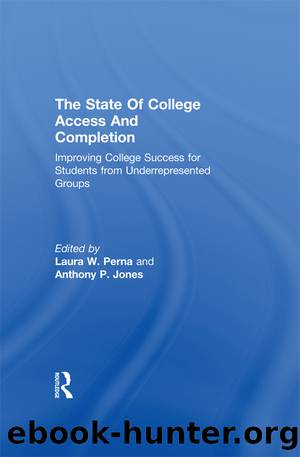The State of College Access and Completion by Perna Laura W.;Jones Anthony;

Author:Perna, Laura W.;Jones, Anthony;
Language: eng
Format: epub
ISBN: 1318972
Publisher: Taylor & Francis Group
Better Aligning Educational and
Organizational Policies Related to Transfer
Overcoming academic and financial barriers to transfer may be negatively offset by the institutional and policy environment in which students study and live. In this section, we identify these environmental factors that ought to be taken into account when devising policies and strategies to improve transfer rates.
Governance and funding structures. Little research on student success examines the effects of state governance and finance structures. This omission from research is perplexing given that states are the greatest providers of higher education funding and, thus, have a significant amount of leverage to incentivize community colleges to increase transfer rates. Since the 1990s, states have used performance measures to ensure that universities and colleges met their intended goals (Burke, 1998). For example, McGuiness (2003) identified 19 different structures used to govern higher education institutions. While some two-year institutions are regulated by the same governing body as the state's four-year university system, other community colleges are governed by local boards.
Literature within the field of public policy lends some perspective on the effectiveness of accountability frameworks for improving the delivery of public services. Heckman, Heinrich, and Smith (2011) found that frameworks that benchmark performance of U.S. workforce training programs failed to produce long-term gains for participants as a result of evidence that suggests accountability measures may influence agency employees to alter conditions to show improved institutional performance. Therefore, the design of accountability frameworks should take into account factors outside the control of agents and effectively balance competing principle interests (Courty, Henrich, & Marschke, 2005). Indeed, Wong (1994) found that efforts to allocate education resources more equitably are constrained by fragmentation in governance. From his analysis, Wong (1994) suggests that equity polices at the local, state, and federal levels work against each other and have, in turn, largely failed to narrow the resource gap between rich and poor districts.
To the best of our knowledge, only one study to date has foregrounded governance within the context of transfer. Wellman (2002) finds that the only difference between states with high versus low grades for retention and completion (according to the state report card produced by the National Center for Public Policy and Higher Education, Measuring Up 2000) was their governance structure. Specifically, Wellman (2002) found that high-grade states governed their postsecondary institutions through a centralized system while low-grade states governed their postsecondary institutions through local boards. This result suggests that states may be able to govern institutions in a way that improves their performance through incentives (Wellman, 2001), but what these incentive structures look like was not identified.
Transfer and articulation agreements. Research examining the effects of state-level factors on transfer has centered on articulation agreements (Anderson, Alfonso, & Sun, 2008; Anderson, Sun, & Alfonso, 2006; Banks, 1994; Goldhaber, Gross, & DeBurgomaster, 2008; Roksa & Keith, 2008; Wellman, 2002), which facilitate the transfer of credit acquired in community college to four-year institutions. How articulation agreements reduce the risk of losing credit in this transfer process varies. As of 2010, the most common approach was a transfer associate's degree; 31 states reported this kind of policy.
Download
This site does not store any files on its server. We only index and link to content provided by other sites. Please contact the content providers to delete copyright contents if any and email us, we'll remove relevant links or contents immediately.
Competing on Culture by VanWagoner Randall;Sydow Debbie L.;Alfred Richard L.;(156)
Teaching Skills For Dummies by Sue Cowley(139)
The Art & Science of Web Design by Jeffery Veen(136)
Maker-Centered Learning by unknow(117)
People Skills by Thompson Neil(113)
Lorange P. Learning and Teaching Business...Lessons...2022 by Unknown(105)
Managing Unstoppable Learning by Hierck Tom;(103)
Motivating Defiant and Disruptive Students to Learn by Rich Korb(102)
The InterActive Classroom by Nash Ron;(98)
Forces of Influence by Ende Fred;Everette Meghan;(96)
Summarization in Any Subject by Wormeli Rick;Stafford Dedra;(95)
Teacher Mentoring and Induction by Portner Hal;(93)
Connecting Through Leadership by Kullar Jasmine K.;(93)
Academic Advising and the First College Year by Jenny R. Fox; Holly E. Martin(92)
Employee of the Month by Tracey Rogers(91)
What We Say and How We Say It Matter by Mike Anderson(87)
Reflective Practice in Action by Farrell Thomas S. C.;(87)
Leveraging Data for Student Success : Improving Education Through Data-Driven Decisions by Laura G. Knapp; Elizabeth Glennie; Karen J. Charles(87)
Teaching Behavior by Terrance M. Scott(83)
